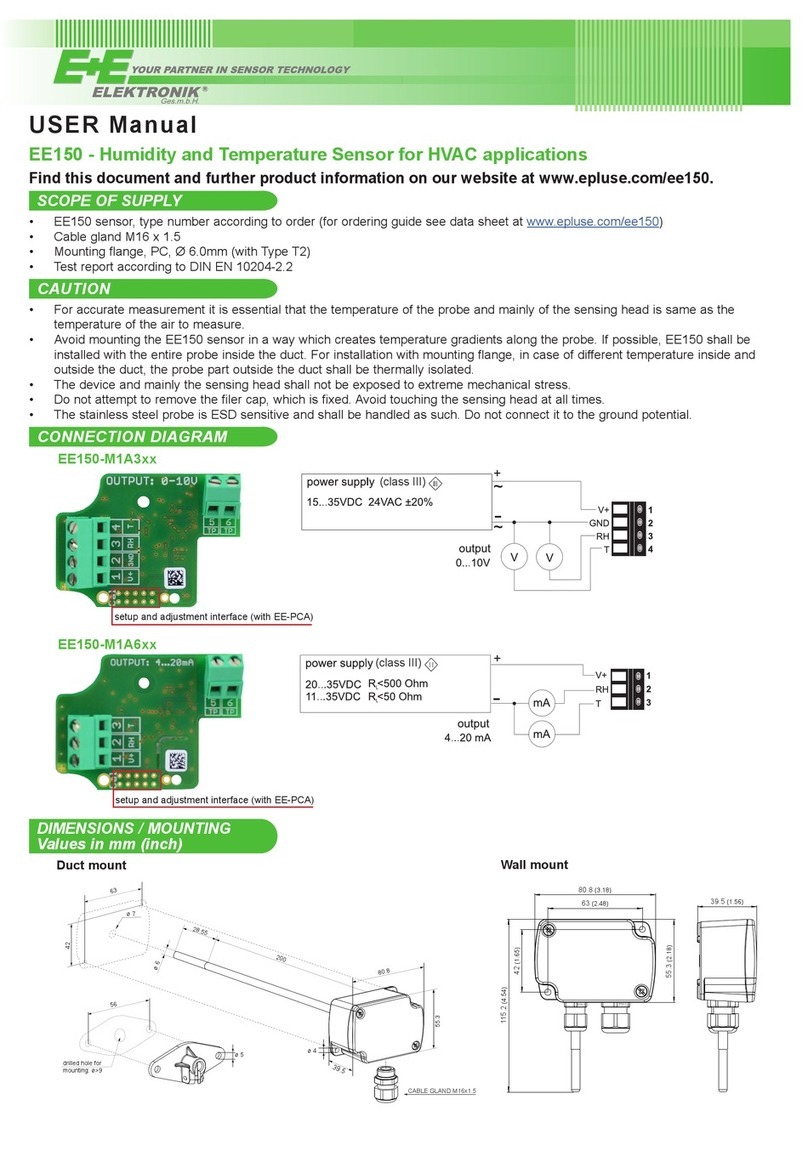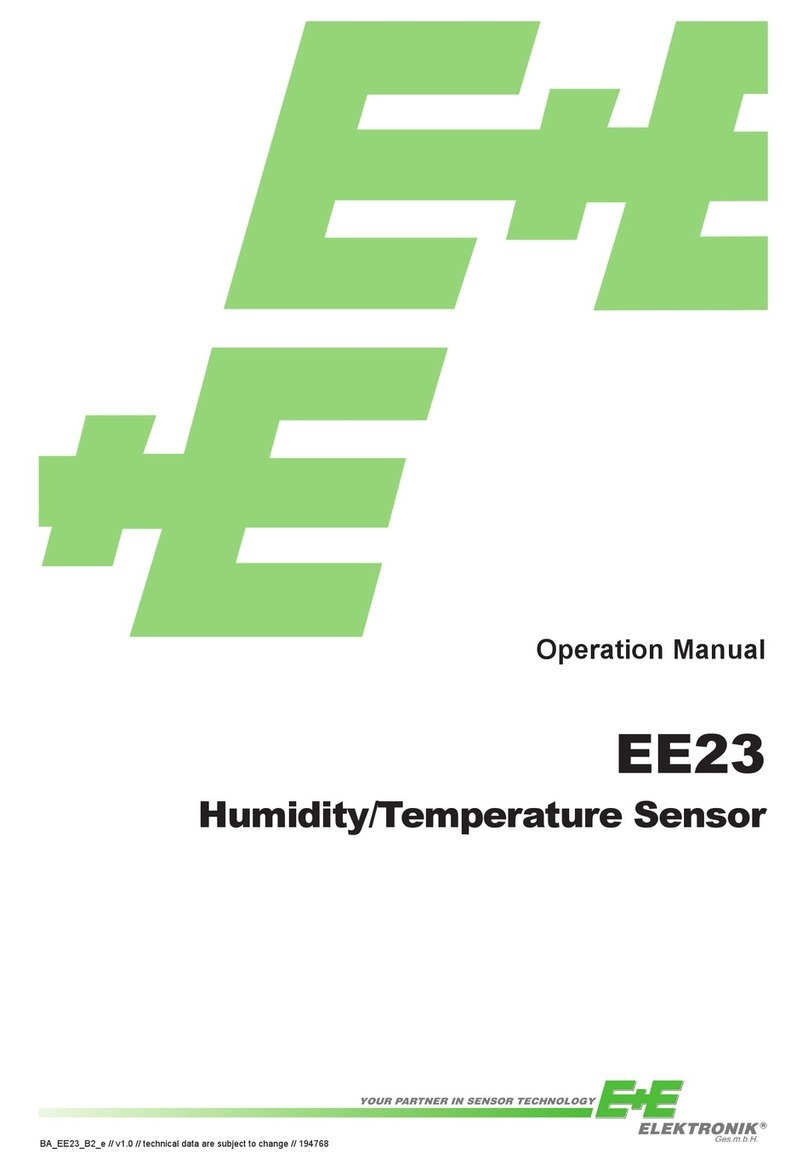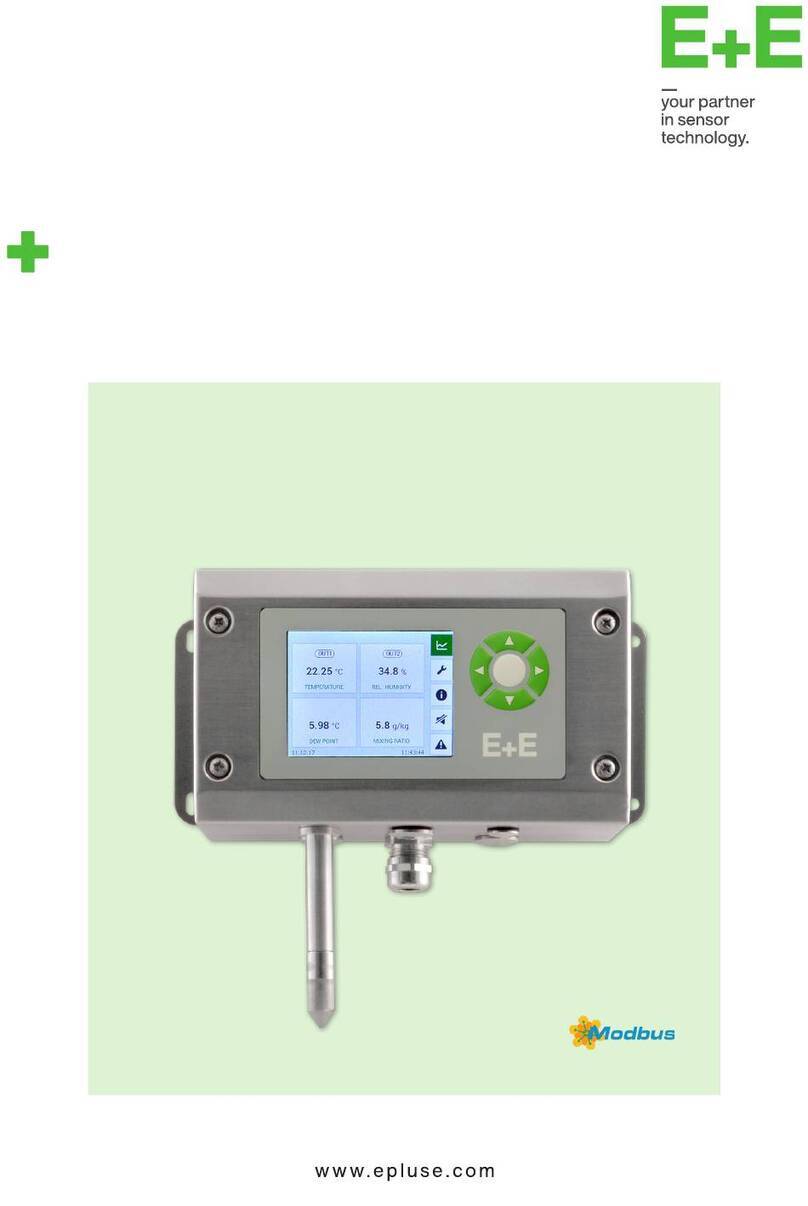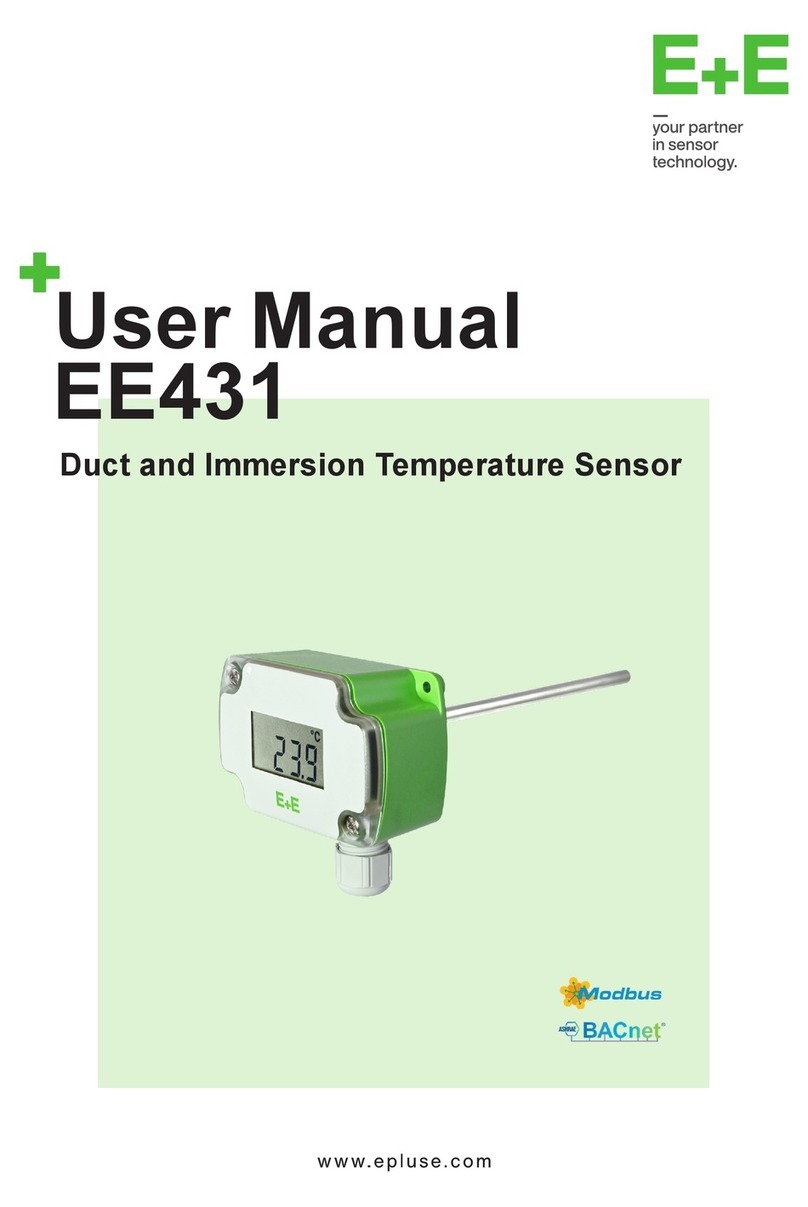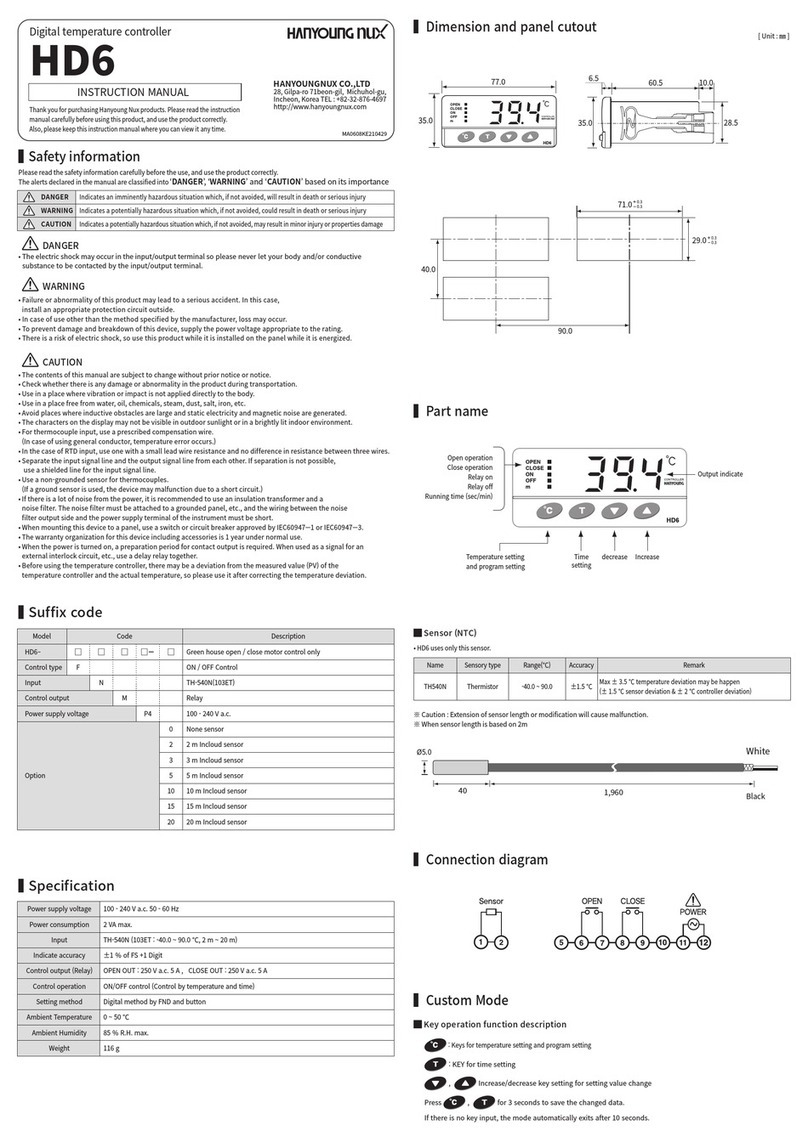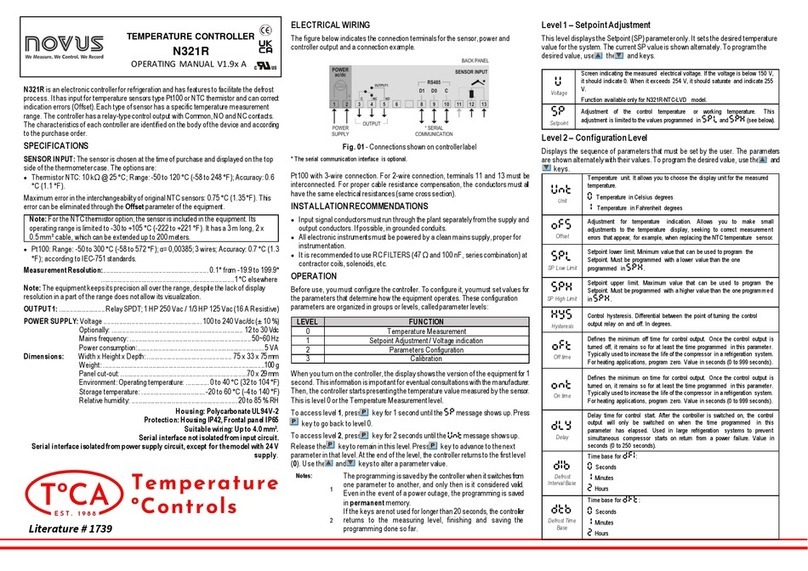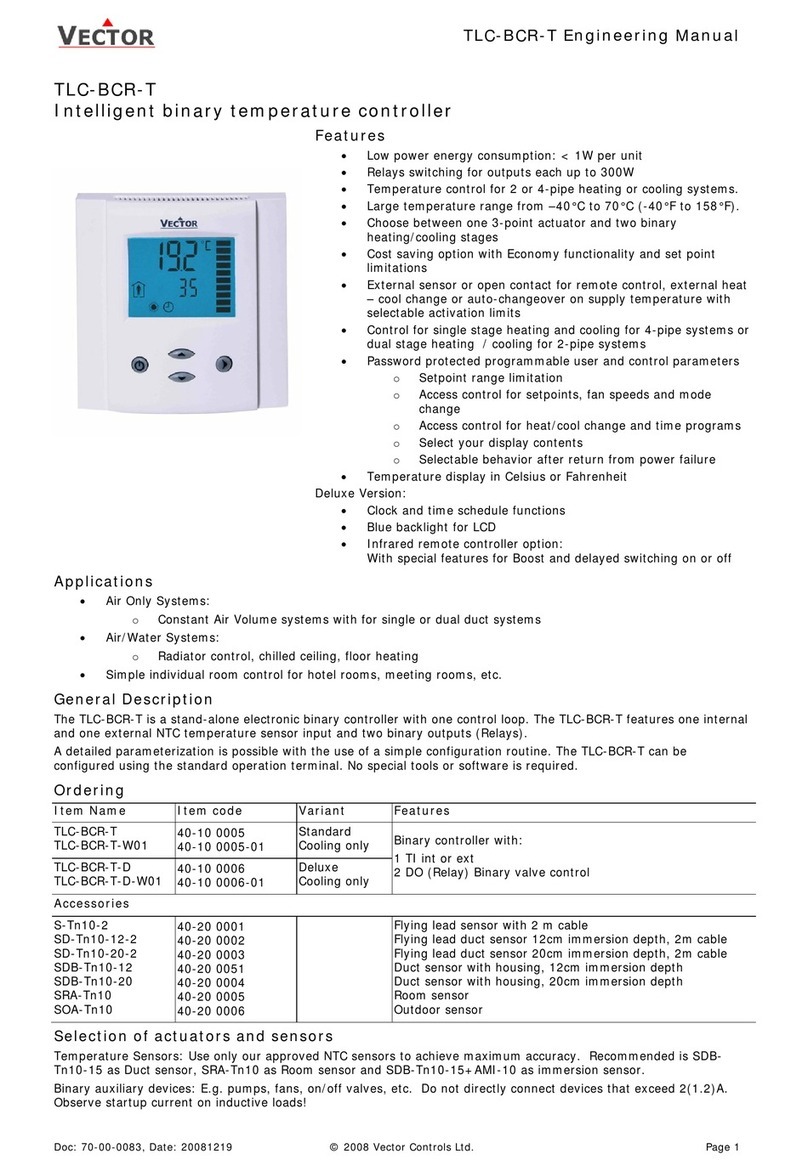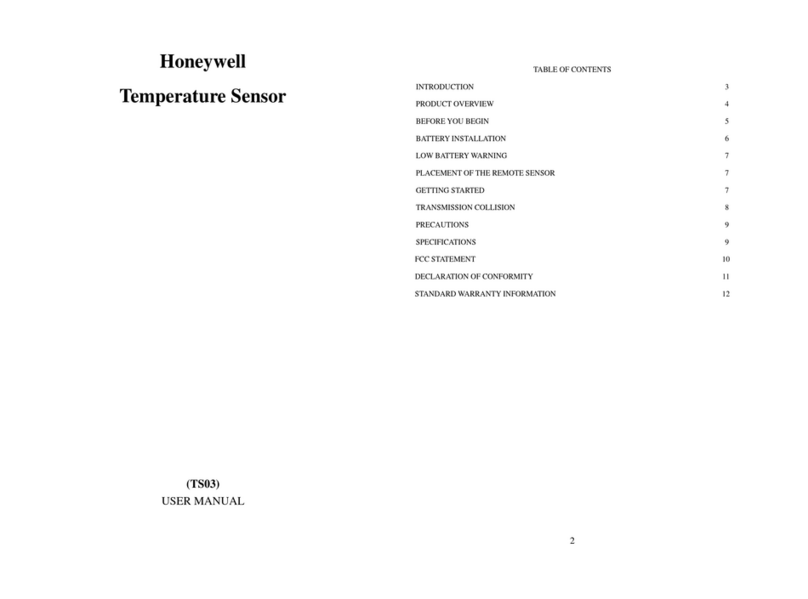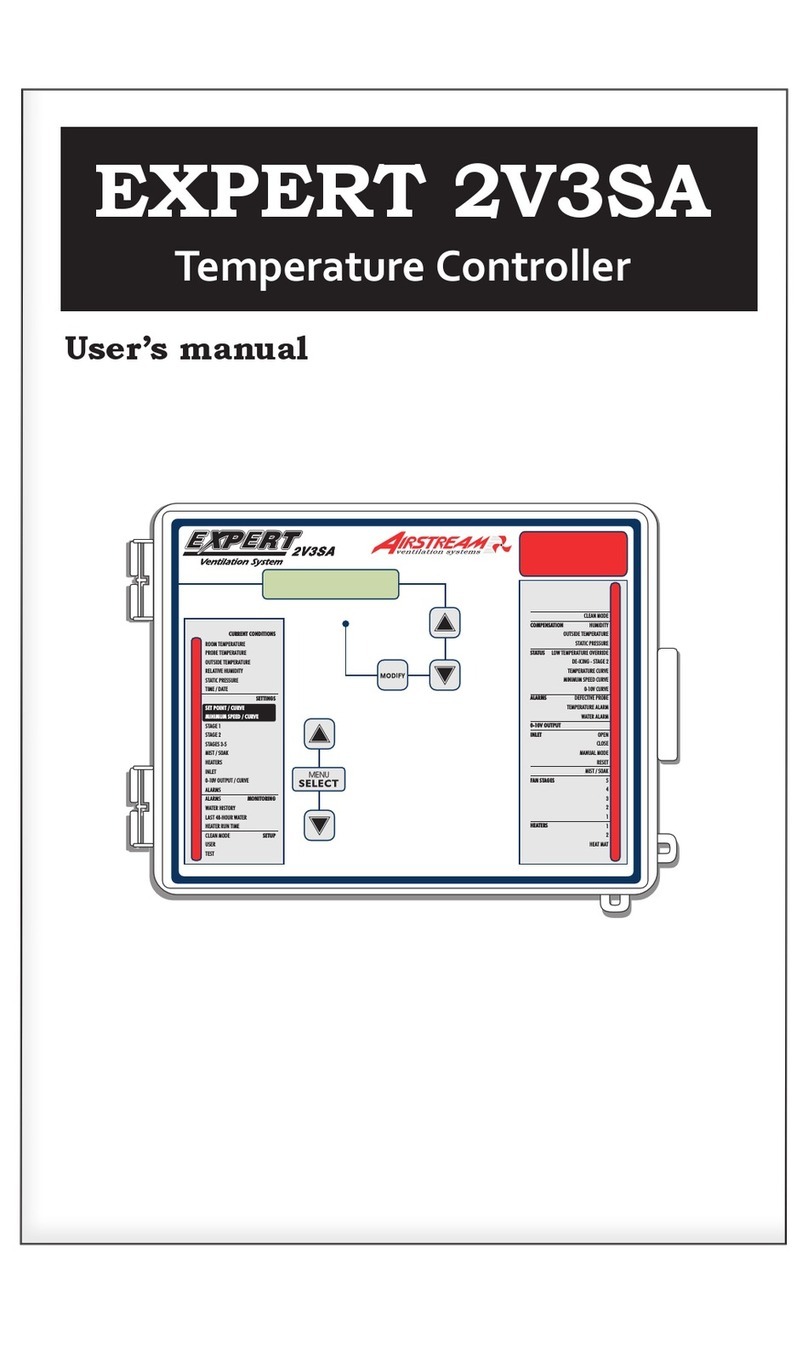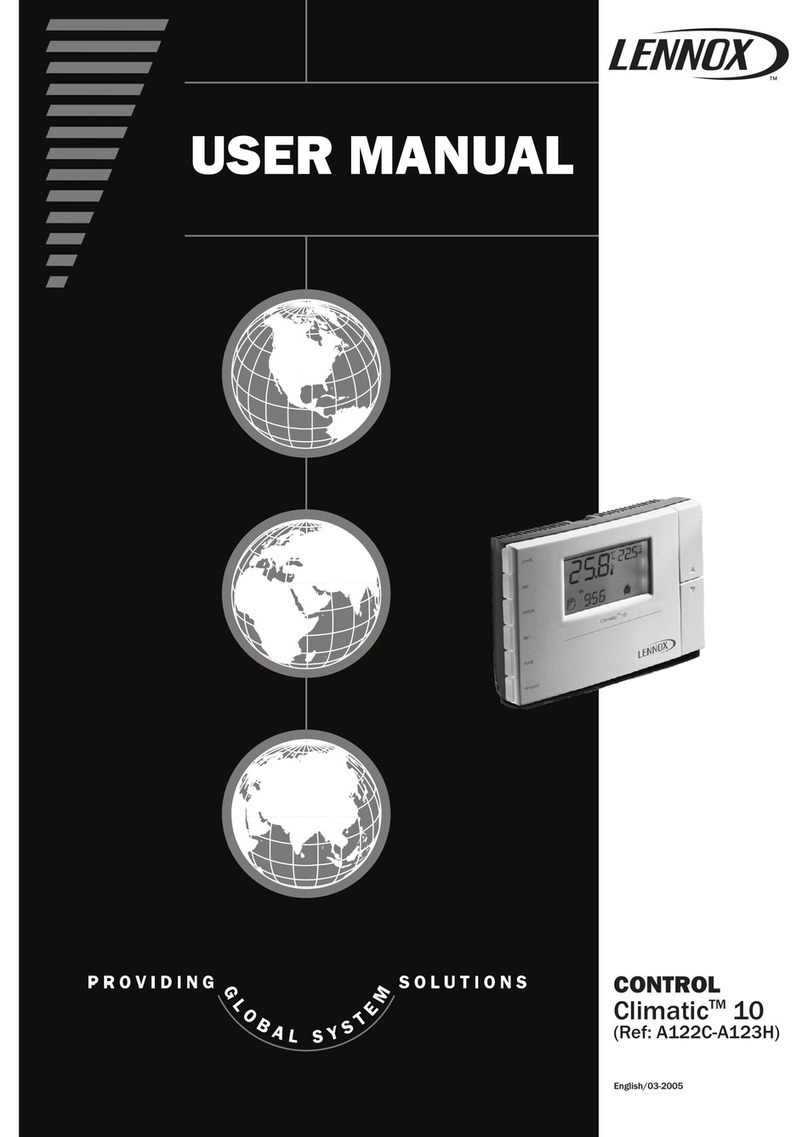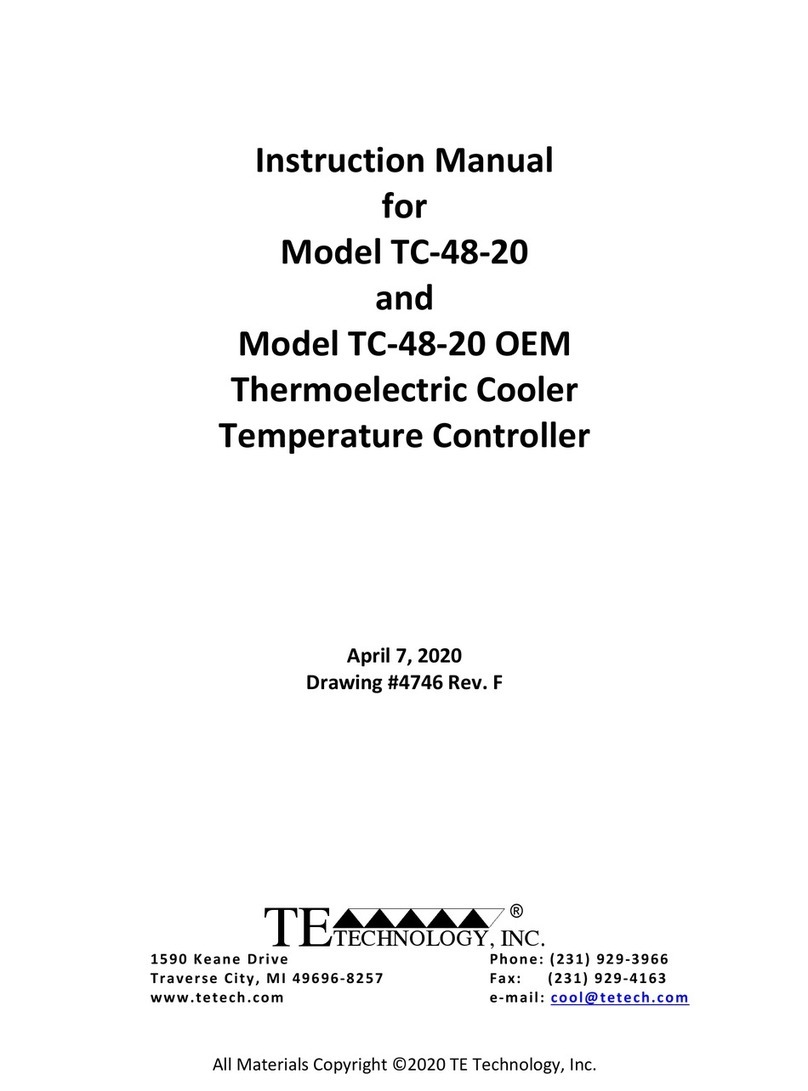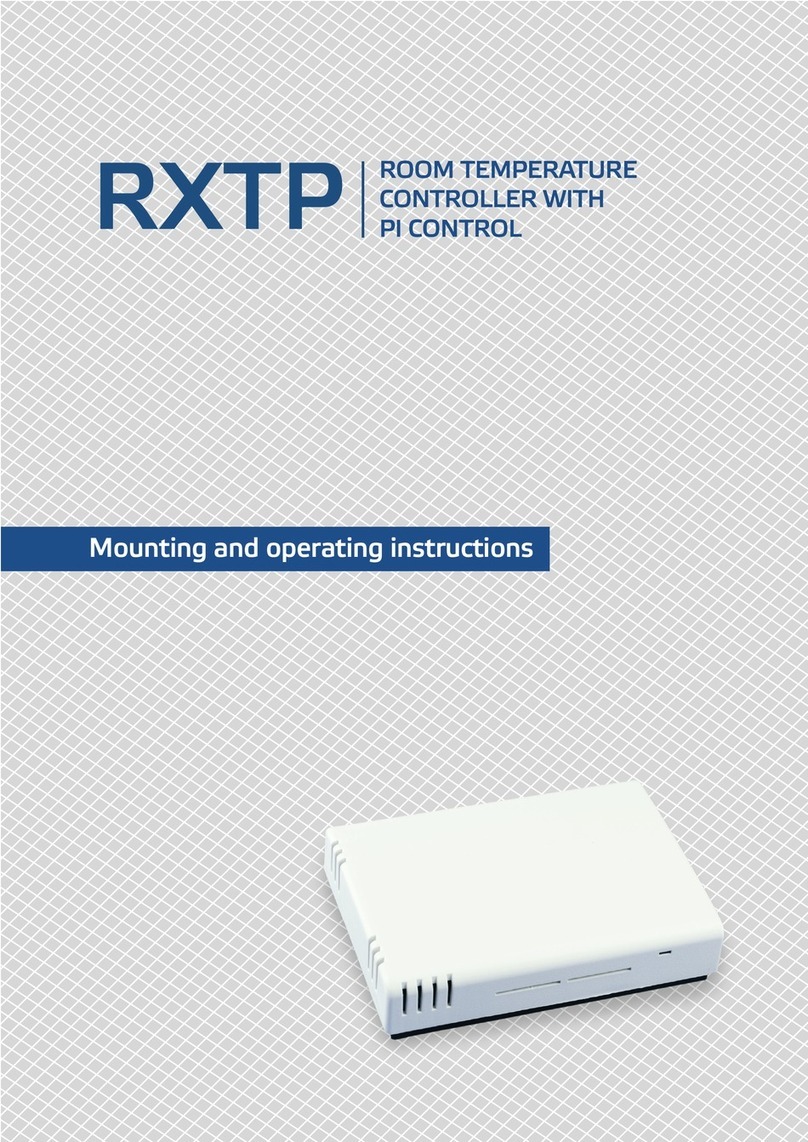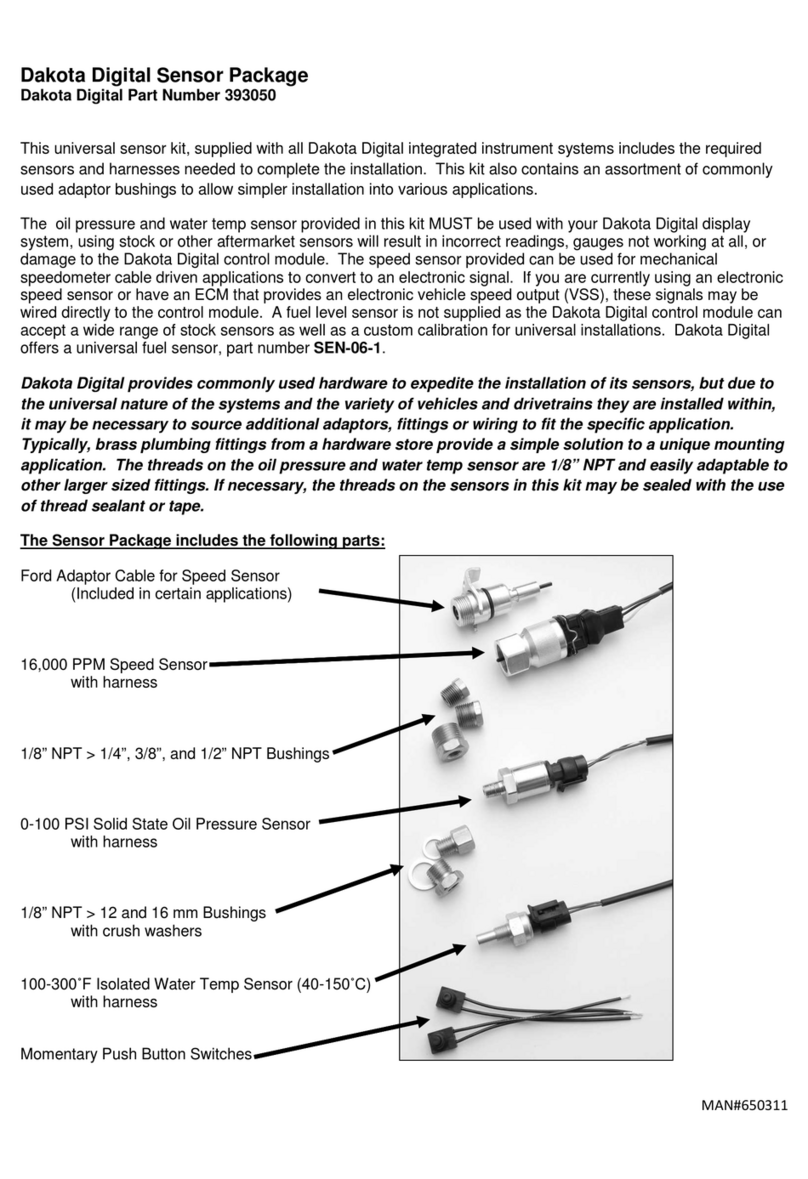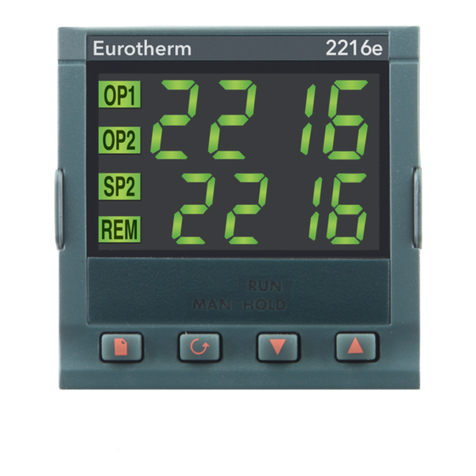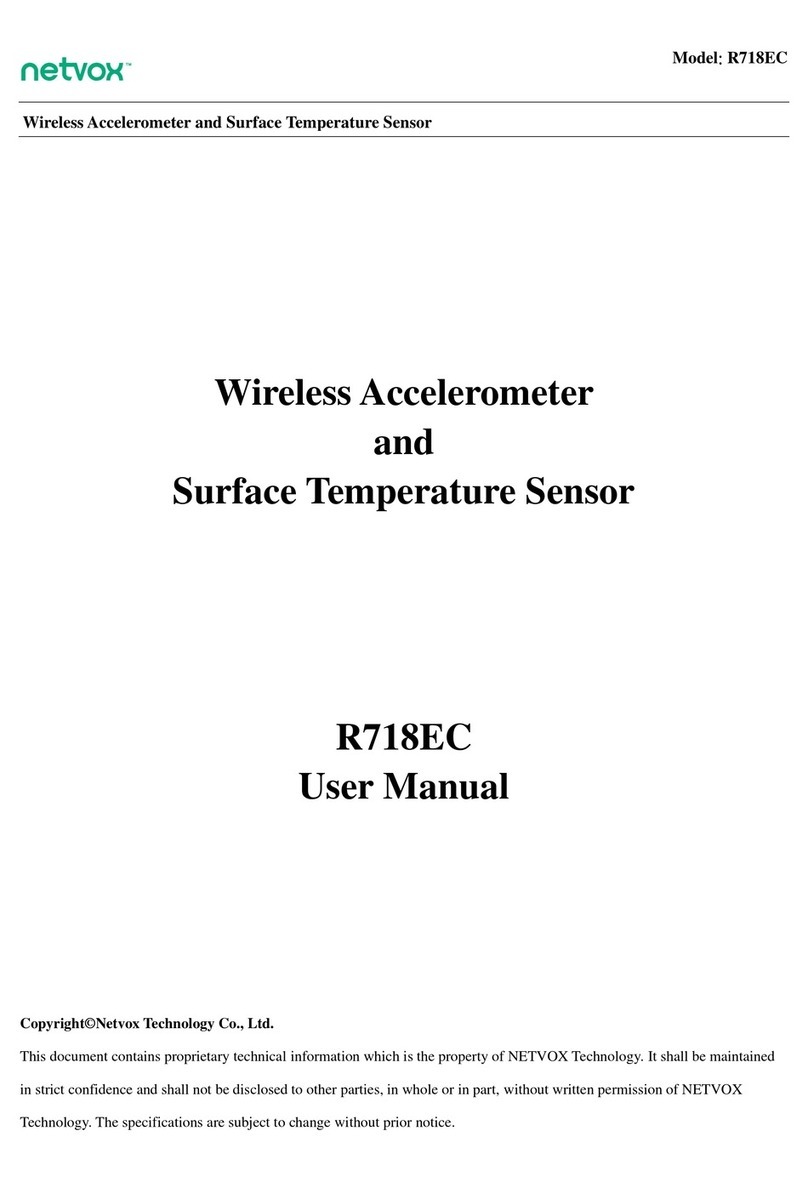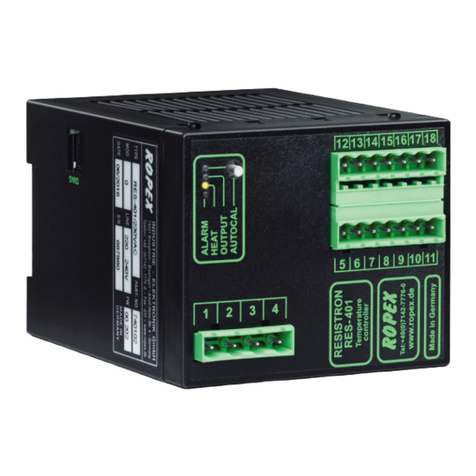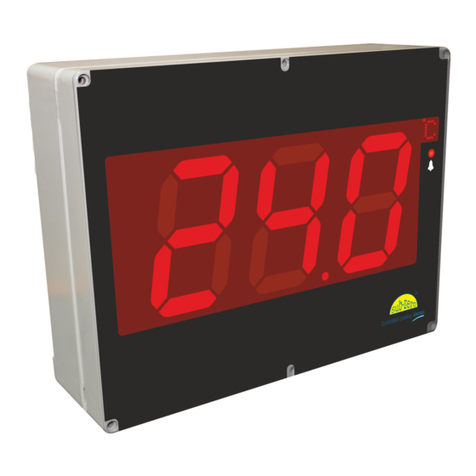E+E Elektronik HCT01 Instruction Manual

Rev. 0.2 / 09 /2015 2
AN1111-2
Developer’s Guide for
HCT01
Humidity and
Temperature
Sensors

Rev. 0.2 / 09 /2015 3
AN1111-2
Table of content:
1Driving circuitry for HCT01 .............................................................................................................. 4
2Pre-adjusted HCT01 with an initial accurate circuitry with frequency output .................................. 6
2.1 Schematic circuit diagram ....................................................................................................... 6
2.1.1 Bill of Material................................................................................................................................ 6
2.1.2 Correlation between sensor capacity and period........................................................................... 7
3RH measurement with pre-adjusted HCT01 and microcontroller based, initially accurate circuitry 8
3.1 Schematic circuit diagram ....................................................................................................... 8
3.1.1 Bill of Material................................................................................................................................ 9
4Hints for the development engineer .............................................................................................. 11
5Contact information ....................................................................................................................... 12
6Revision history ............................................................................................................................. 12

Rev. 0.2 / 09 /2015 4
AN1111-2
1 Driving circuitry for HCT01
HCT01 is a capacitive, thin-film sensor for relative humidity (RH) in a robust SMD enclosure. The
enclosure can accommodate an optional high precision temperature (T) sensor – a prerequisite for
precisely calculating dew point.
The enclosure provides optimal mechanical sensor protection and can be used with a standard reflow
process. The E+E proprietary coating protects the active surface of the RH sensor against dust, salt
and other corrosive or low impedance deposits.
The choice of HCT01 sensor type
HCT01 is available as pre-adjusted ( HCT01-02 and HCT01-03) or unadjusted HCT01-00 RH sensor,
each of these with or without integrated T sensor. The choice is based on accuracy requirements, on
the availability of humidity calibration benches, on the available or intended driving electronics and on
cost/performance considerations and it is illustrated in Figure 1. Additionally, Figure 1gives an
overview on the accuracy which can be achieved by various combinations of HCT01 circuitry.
•Using an unadjusted RH sensor (HCT01-00) implies humidity calibration for the device built
with it. The accuracy achieved depends mainly on the overall uncertainty of the calibration
process.
•A pre-adjusted RH sensor (HCT01-02/03) eliminates the need for humidity calibration. The
accuracy of the final device rests solely on the spread of the initial accurate electronics
employed.
The choice of driving circuitry
The driving circuitry for HCT01 can be realized with an oscillator as “capacity to frequency converter”
or with a microcontroller.
Features of the capacity to frequency converter:
Cost efficient solution – material costs approx. 0,25 € (using an existing oscillator)
Accuracy ±0,8 % rH
Extremely short measuring time possible to save power and prevent self heating
Frequency (period) output
Features of the microcontroller based circuitry:
Cost efficient solution – material costs approx. 0,05 € (using an existing microcontroller)
Electronic accuracy of ±1 % rH with reference adjustment
Customer specific, digital output depending on the microcontroller

Rev. 0.2 / 09 /2015 5
AN1111-2
Choice of HCT01 version and driving circuitry
Figure 1: Circuitry options for HCT01

Rev. 0.2 / 09 /2015 6
AN1111-2
2 Pre-adjusted HCT01 with an initial accurate circuitry
with frequency output
The circuitry in Fig. 2 delivers a frequency output signal, where the period of the signal is proportional
to the capacity of the RH sensor and consequently with the relative humidity at the sensor. The
accurate measurement of the period requires a precise time base such as a quartz crystal.
2.1 Schematic circuit diagram
Figure 2: Circuitry with frequency output
2.1.1 Bill of Material
Quantity
Symbol
Device
Dimension
Supplier
1 pc
HCT01
Humidity sensor
HCT01-02 or HCT01-03
E+E Elektronik
1 pc
IC1
Existing
comparator
MCP6561T
Microchip
1 pc
C1
Capacitor
100 nF, ceramic
1 pc
R1
Resistor
82 kΩ
2 pcs
R2, R3
Resistor
100 kΩ
2 pcs
R4, R5
Resistor
1 kΩ

Rev. 0.2 / 09 /2015 7
AN1111-2
2.1.2 Correlation between sensor capacity and period
•Humidity Sensor HCT01 (approx.): 70 pF @ 0 % rH -95 pF @ 100 % rH
•Period at RH_OUT: 70 pF 19.0 µs cycle duration
95 pF 25.4 µs cycle duration
Figure 3: The sensitivity is approx. 0,064 µs/% rH (with a rise of 0.25 pF/% rH)
Figure 4: Nominal characteristic of the measuring device with frequency output
Figure 5: Example of RH & T measuring device with HCT01 and frequency output
19
20
21
22
23
24
25
26
0 10 20 30 40 50 60 70 80 90 100
cycle period [µs]
relative humidity [% rH]
Nominal characteristic @5,0 V

Rev. 0.2 / 09 /2015 8
AN1111-2
3 RH measurement with pre-adjusted HCT01 and
microcontroller based, initially accurate circuitry
A measuring device with pre-adjusted HCT01 and with a microcontroller based initially accurate
circuitry can achieve an accuracy of ±2,24 % rH.
A detailed description of the circuitry is available in the E+E patent EP 1 574 847 B1 // US 7,084,644
B2.
3.1 Schematic circuit diagram
Figure 6: Schematic circuit design1
There are three possible measurement paths:
1.) Sensor (capacitance) path with R1 + HCT01 + D1 + C2 (= CL)
2.) Reference (capacitance) path with R2 + C_REF + D1 + C2 (= CL)
3.) Calibration (capacitance) path with R3 + C_CAL + D1 + C2 (= CL)
U
L
= voltage at C
L
(=C2)
U
V
= Voltage at the voltage
divider (reference voltage)
1C_REF = ±1% @82 pF = ±0.82 pF ≈ ±3.4 % rH
C_Cal= Capacitance which is used for calibration end testing [no soldering necessary]

Rev. 0.2 / 09 /2015 9
AN1111-2
All three measurement paths (“sensor” or “reference” or “calibration”) use the same
algorithm.
Example: reference path:
1.) Discharge all capacitors (I/O pins RC1, RC5, RC6, RC7 and RA2 = output LOW)
2.) Charge reference capacitor and CL(RC6, RC5, RA2 = input, RC1 = switched to
comparator input, RC7 = output HIGH). The charge from the reference capacitor
is also transferred in the capacitor C2 (=CL) and the voltage in C2 (=CL) rises a
little bit. C2 is approx. 10.000 times higher than C_REF.
3.) Discharging reference capacitor (RC6, RC5 = input, RC1 = switched to
comparator input, RA2, RC7 = output LOW).
4.) Increment the number of charge/discharge events (in this case N_CRef).
5.) Check if the voltage at the pin RC1 (comparator) reaches the voltage at the
voltage divider:
no repeat point 2.) and recharge the reference.
yes end of loop and save the numbers of charge/discharge events.
6.) Each cycle measures the reference path and the sensor path and calculates the
sensor capacitance from these measurements.
3.1.1 Bill of Material
Quantity
Symbol
Device
Dimension
Supplier
1 pc
HCT01
Humidity sensor
HCT01-02 or HCT01-03
E+E Elektronik
1 pc
D1
Fast Si-Diode
1SS400TiG
1 pc
C2
Resistor
1 µF, ceramic / X7R
1 pc
Existing
microcontroller
PIC16F690
Microchip
1 pc
C_REF
Capacitor
82 pF, ceramic / NP0 / CG0
5 pcs
R1-R5
Resistor
470 Ω
Requirements for the microcontroller
1.) 3 to 4 digital I/O pins, switchable between output and (analog) input
2.) Integrated comparator (switchable to digital I/O output), external component also possible
3.) Integrated voltage divider (used as reference voltage at comparator), external component also
possible

Rev. 0.2 / 09 /2015 10
AN1111-2
The nominal characteristic of the device (HCT01 sensor together with electronics) can be determined
by measurement at various levels of relative humidity.
Figure 7: Example of nominal characteristic
The deviation from the reference RH after correcting for PCB influences and hysteresis is shown in
Figure 8.
Figure 8: Initial accurate electronics – w/o C_Cal: PCB corrected
0
10
20
30
40
50
60
70
80
90
100
0 10 20 30 40 50 60 70 80 90 100
digital capacitance values [pF]
relative humidity [% rH]
Example of nominal characteristic @3V3
-5,0
-4,0
-3,0
-2,0
-1,0
0,0
1,0
2,0
3,0
4,0
5,0
0 20 40 60 80 100
deviation relative humidity [% rH]
relative humidity [% rH]
Initial accurate electronics, 55 units @3V3
w/o C_CAL ; PCB corrected ; w/o hysteresis; nominal
characeristic

Rev. 0.2 / 09 /2015 11
AN1111-2
For even better overall uncertainty, measure each PCB with a very well defined C_CAL during the
electrical test of the PCB. Correct the C_REF based on this measurement, or determine the exact
value of C_REF during the PCB in circuit test.
The deviations from reference with C_CAL = 82.79 pF are shown in Figure 9.
Figure 9: Initial accurate electronics – 1 point C_Cal; PCB corrected
4 Hints for the development engineer
Choose HCT01 version and the driving circuitry according Figure 1 depending on the accuracy and
output requirements as well as on existing electronics.
For accurate measurement it is of utmost importance to reduce as far as possible any stray
capacitance (and by this also its variation with temperature and humidity) related to the printed circuit
board. This might require several test and layout optimizing loops. These imply tests for assessing the
impact of the stay capacitance and its variations on the output signal of the device, as follows:
1. Test a sample of relevant size at defined environmental conditions (various combinations of
humidity and temperature) for determining the spread of the characteristic of the device including
HCT01 sensor.
2. Test a batch of printed circuit boards with a known, accurate capacitor instead of the humidity
sensor at defined environmental conditions (various combinations of humidity and temperature) for
determining the impact of the board on the output signal.
The electronics design shall be optimized for narrow spread of the characteristic of the entire device
and for minimum impact of the electronics layout on the output signal.
-5,0
-4,0
-3,0
-2,0
-1,0
0,0
1,0
2,0
3,0
4,0
5,0
0 20 40 60 80 100
deviation relative humidity [% rh]
relative humidity [% rH]
Initial accurate electronics, 55 units @3V3
1 point C_CAL ; PCB corrected ; w/o hysteresis; nominal
characeristics

Rev. 0.2 / 09 /2015 12
AN1111-2
5 Contact information
E+E Elektronik Ges.m.b.H.
Langwiesen 7
A-4209 Engerwitzdorf
Austria
Tel.: +43 7235 605 0
Fax.: +43 7235 605 8
E-Mail: info@epluse.com
Homepage: www.epluse.com
Please visit our website to find your local contact.
6 Revision history
Date
Revision number
Changes
November 2011
V_0.1
Initial release
September 2015
V_0.2
Revised version
Copyright© 2014, E+E Elektronik.
Subject to technical changes and misprints
All rights reserved
This manual suits for next models
3
Table of contents
Other E+E Elektronik Temperature Controllers manuals
